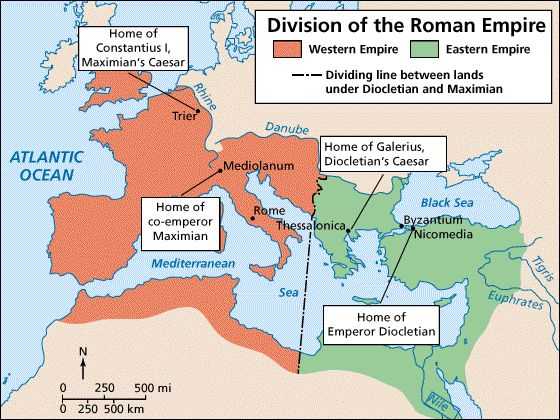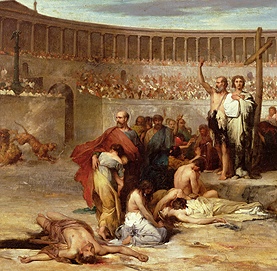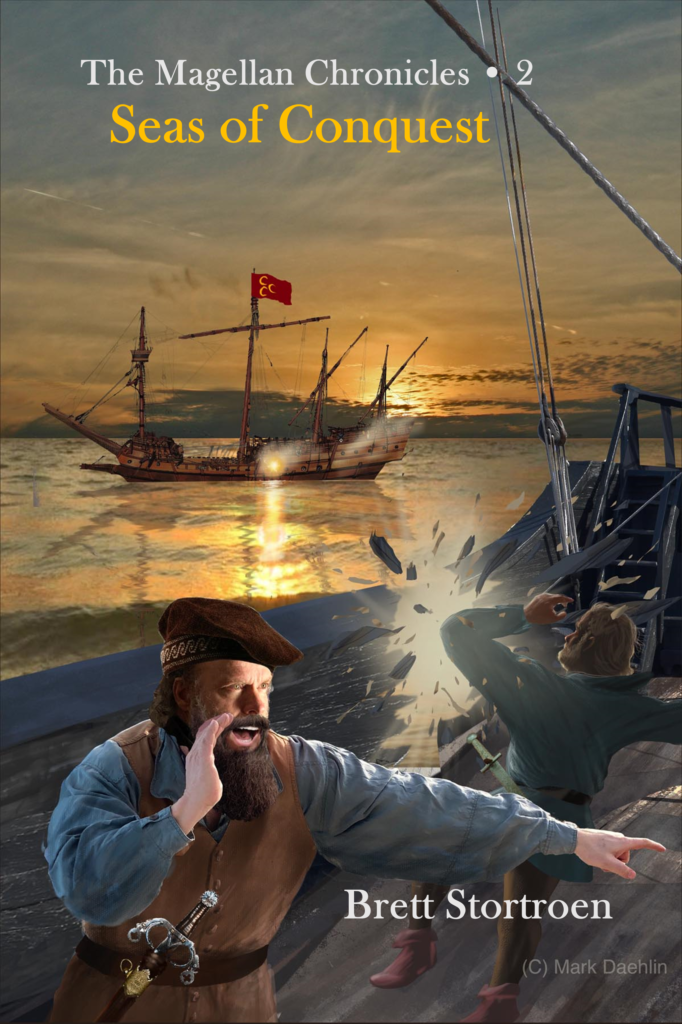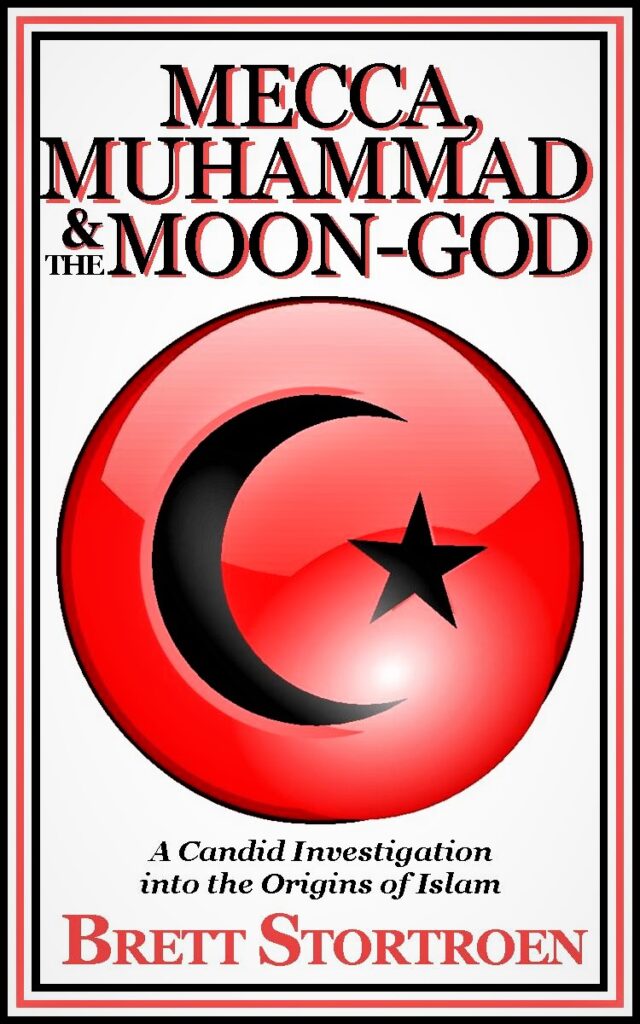Throughout history, a general purging of the military remains a persistent theme in tyrannical regimes. Absolute obedience to the state collective was considered imperative. The ruling elite feared any opposition or usurpation among the armed forces and were the first targets in screening their loyalty. Rome’s greatest purging of Christians in the military began around 299, in the years leading up to the great empire wide persecutions which lasted from 303 to 311 C.E.
293 – Tetrarchy (rule of four) Created
1. Diocletian Augustus Jovius
2. Galerius Caesar Jovius
3. Maximian Augustus Herculius
4. Constantius Caesar Herculius
Of these four only Constantius refrained from overt attacks against Christians. He razed some churches to feign compliance but harmed none.
Galerius’ Influence upon Diocletian
From the historical sources one may deduce that Galerius was the main instigator and often prodded Diocletian to rid the empire of Christians.
“Galerius had effectively planted the first seed. Lactantius blamed Galerius’ mother Romula, a pagan priestess in her native Moesia (today’s Bulgaria), ‘an extremely superstitious woman who worshipped the mountain deities,’ and who was enraged ‘by the contempt the Christians showed to her scarifices . . . She incited her son, more superstitious than even herself, to turn against those people.’ Whatever the personal motives or his mother’s influence, Galerius was the man who suggested to Diocletian that the Christians should no longer be allowed to offend the gods by refusing sacrifice. A few extreme and rather unusual cases of defiance in the army fueled Galerius’ arguments and gave them a sense of urgency.” (Kousoulas, 94-95)
Diocletian’s Role as Dominus (Lord)
Perhaps the competition for his role as Lord of the empire was at stake in the mind of Diocletian. His imperial majesty and iron fisted control was crucial in crushing rebellions and maintaining the ordered peace of Rome. The Christians were not in compliance.
“Other officials told the emperor . . . ‘The Christians’ first loyalty.’ They added, ‘is to a crucified Jew they address as Dominus, claiming that he is their Lord and Savior.’ This last argument impressed Diocletian the most.” (Kousoulas, 95-96)
This may have appeared as a direct threat to his own status as Dominus of Rome. Diocletian raised the status of emperor to a level higher than anyone prior. The esteemed historian, Roger Rees, comments:
“Eutropius, Ammianus Marcellinus, and also Jerome attribute to Diocletian the beginnings of an elaborately stylized monarchy, characterized by expensive purple dyes, fine silks and jewels, and the obligation on those approaching the emperor to worship him as a god.” (Rees, 46)
“. . . for he (Diocletian) was the first of all emperor’s after Caligula and Domitian to allow himself to be called ‘master’ in public, to be worshipped and addressed as a god.” (Rees, 93; quoting Sextus Aurelius Victor: Book of the Caesars c. 361)
“. . . and he demanded that he be worshipped, where all previous emperors had been greeted. He ornamented his clothes and shoes with jewelry, where before the badge of imperial office was only the purple robe and everything else ordinary.” (Rees, 100; quoting Eutropius’ Brevarium c. 369)
Only a few were allowed within the emperor’s presence. Those admitted were required to bow and kiss the hem of his robe while eyes averted downward. This was called proskynesis in the Greek. Diocletian may have literally believed he was the god Jupiter incarnated in human flesh. Nevertheless, he gradually succumbed to Galerius’ advice out of his own superstitious fears. In his reasoning, the state must have unity of religion, with the exclusion of all others, in order to appease the gods and maintain roman hegemony. The whole collective of society had to be in compliance with the state at all cost. Eusebius, the court historian and Christian chronicler, specifically cited the initial tide of persecution:
“. . . and with the Christians in the army the persecution began.” (Eusebius, 328)
Eusebius further infers this was a result of Galerius’ instigation:
“It is on record that he had been the prime mover in the calamitous persecution, for long before the other emperors made a move he had used physical violence to pervert the Christians in the armed forces, after starting with the members of his own household. Some he had deprived of military rank, some he had insulted most shamefully, others he had actually threatened with death. Finally, he had incited the fellow-emperors to undertake a worldwide persecution.” (Eusebius, 355)
Martyrdom of Centurion Marcellus
One of the early examples of martyrdom within the legions occurred in 298, in the city of Tingis (Tangiers), on the northwest coast of Africa. Marcellus, a seasoned veteran with rank of centurion in the Trajan legion was in attendance for the birthday celebration of Emperor Maximian. Abbot Giuseppe Ricciotti relates the account:
“. . . Marcellus, instead of offering incense in the tripods, flung his belt to the ground before the legionary eagles exclaiming, ‘I am a soldier of Jesus Christ.’ He then threw away his staff of vine plant which was the insignia of a centurion declaring: ‘If to be a soldier means sacrificing to gods and emperors, behold I cast away my staff and belt and do not wish to serve.’ This was a serious act, both because Marcellus’ rank and because of its public nature.” (Ricciotti, 39)
Marcellus was given a trial and received the sentence of death. A Christian secretary named Cassian, outraged by the verdict, threw down his tablet and pencil and remarked the decision was unjust. Both were executed by the roman authorities.
Philosophers Incite the Christians
For the years leading up to the great persecution, the state literary elites of the time issued forth aggressive polemics against the Christians. In response, the famed Christian Lactantius became an ardent defender of the faith. Regardless, Diocletian and Galerius were in constant sympathy of any suspicions directed against those who refused to sacrifice to the gods of Rome and cause disunity in the empire. Stephenson comments:
“And in Nicomedia, Lactantius, a North African professor of Latin rhetoric, rubbed shoulders with the administrator-cum-polemicist Sossianus Hierocles and the philosopher Porphyry. These last two men are often held up as the intellectual architects of a revived attack on Christians, which was so vicious and protracted that it became known as the Great Persecution.” (Stephenson, 104)
Oracles Blame the Christians
In 299 a shocking event further incited Diocletian’s distrust of Christians.
“Once when he (Diocletian) was involved in the east, he was sacrificing cattle and searching in their innards for portents. At that moment, some of his attendants present at the sacrifice who had knowledge of the lord put the immortal sign on their foreheads; the demons were put to flight by this action, and the rites were disturbed. The haruspices were anxious and they did not see the usual signs in the entrails, and so, as if they had not made offerings, they sacrificed more times. Again and again the sacrificial victims yielded no sign, until Tagis the chief haruspex said, either out of suspicion or insight, that the rites were not responding because profane men were present at the religious ceremony. Wild with anger at this, Diocletian ordered that not only those attending the rites make sacrifice, but even everyone in the palace, and that if they refused they be flogged as punishment; and he instructed that letters be sent to commanders and soldiers be forced to make the unspeakable sacrifices and that those who disobeyed be discharged from service.” (Rees, 107)
The purge spread throughout the military. Ricciotti describes the fallout:
“Very many, on the other hand, were expelled from the army and lost their social position. Officers were punished by the gradus deiectio – reduction to the ranks; private soldiers were given the ignominiosa mission, that is, discharge with ignominy, which brought with it; loss of the title of ‘veteran’ and the advantages which went with it; in both cases there came out men who had been cast off by society and economically ruined. Despite all this, as Eusebius says, there were very many who resisted.” (Ricciotti, 36)
In 302, Galerius met with Diocletian again to further escalate his agenda against the Christians.
“. . . Diocletian, still searching for answers, ‘sent a haruspex to the oracle of Apollo at Didyme,’ near the ancient town of Miletus. Constantine himself, was at the court when the reply came and years later he told the story to Eusebius. ‘[The haruspex reported] that Apollo spoke from a deep and gloomy cavern through a medium, and the voice was not human. [The god] declared that the pious on Earth were preventing him from speaking the truth and that therefore the oracles that issued from his tripod were without value. This is why he hung down his hair in grief, mourning all the evils that will come to men from the loss of his prophetic spirit. Constantine told Eusebius; ‘I heard the senior Augustus asking his advisors: Who were the pious on Earth? And one of the pagan priests replied: ‘The Christians, of course.’ The Christians indeed were the pious or in Greek evseveis in referring to themselves.” (Kousoulas, 97)
Diocletian’s superstitious mind absorbed these oracular events. Galerius continued to push and prod with constant warnings. Finally, the storm broke. The first edict of the “Great Persecution” was posted in Nicomedia on April 23, 303.
“Terminalia festival of 23 February was chosen . . . When it was twilight that day, the prefect came to the church with generals, tribunes and accountants, and beat the doors down; they looked for the image of God, burnt the scriptures they found, granted booty to everyone, caused plunder, fear, panic . . . In a few hours the highest building was leveled to the ground. The next day an edict was posted warning that people of that religion would be stripped of all rank and status, that they would be subjected to torture, no matter their class or position.” (Rees, 108; quoting Lactantius, On the Deaths of the Persecutors c. 315)
During these tumultuous years arose the legendary tribune Saint George. Theoretically, he may have even accompanied Diocletian to Alexandria in 298. George was famous for his slaying of the dragon in Libya. George was stationed in Nicomedia when the edict of 303 was posted. His Christian conviction could not allow inaction. He tore down the edict in defiance of the unholy decree. The young tribune, Constantine, was likely an eyewitness to the brutal torture and epic martyrdom of St. George which may have sparked the first flames of faith in the future Christian emperor.
Night of the Dragon. The Saga of Saint George
Fire in the Imperial Palace Escalates Persecution
Galerius’ hunger for Christian blood was still not satiated. Thus he initiated a ‘false flag’ event to escalate the slaughter of Christians.
“But Galerius was not content with the rulings of the edict; he prepared to beleaguer Diocletian by other means. To force him to a policy of the cruelest persecution, he had attendants secretly start a fire in the palace, and when part of it had burnt down, the Christians were denounced as public enemies. . . . So he [Diocletian] now began to rage not just against his household staff but against everyone, and first of all he forced his daughter and his wife Prisca to be tainted by making sacrifice. Eunuchs, onetime so powerful, the support for the palace and the emperor himself, were killed; priests and deacons were seized and condemned without proof of confession, then led away with all their dependents. People of both sexes and every age were taken for burning, not individually since they were so great in number, but in groups they were surrounded by flames; with millstones tied to their necks, household staff were drowned in the sea. The persecution fell no less violently to the rest of the population. For judges were sent to temples and tried to force everyone to sacrifice. The prisons were full, unknown forms of tortures were invented . . . altars were put up in council chambers and law-courts so that litigants could sacrifice first and thus plead their case . . . Orders to do the same thing had been sent by letter to Maximian and Constantius . . . Maximian happily obeyed.” (Rees, 108; quoting Lactantius On the Deaths of the Persecutors c. 315)
Soon after, another fire was set ablaze in the imperial palace which solidified Diocletian’s resolve to extinguish the Christian presence throughout the empire. Another edict was proclaimed in 303 forcing all clergy to be imprisoned. Later in 304, all citizens, regardless of sex or age, throughout the empire, were compelled to sacrifice. Many of the provincial governors were ruthless and performed roll calls and house searches to strictly force compliance with the latest edict. Thus, there followed an escalation in brutality of an unimaginable scale. The following accounts remain only a small sampling of the horrors which were unleashed over the following years until 311.
“. . . a royal edict directed that the rulers of the churches everywhere should be thrown into prison and bonds. What was to be seen after this exceeds all description. A huge mass were imprisoned in every place; and the prisons everywhere . . . were filled with bishops, presbyters and deacons, . . . so that no room was left for those convicted of crimes. . . . but that those who refused should be harassed by many tortures, how could one tell the number of martyrs in every province, and especially of those in Africa, and Mauritania, and Thebais, and Egypt? From this last country many went into other cities and provinces, and became famous through martyrdom . . . I was present at Tyre myself when these things [martyrdoms] occurred. . . . Such was the conflict of those Egyptians who contended nobly for religion in Tyre. . . . where thousands of men, women, and children, . . . endured various deaths. Some of them after scrapings and rackings and most severe scourging, and countless kinds of other tortures, terrible even to hear of, were committed to the flames; some were drowned in the sea; others offered their heads bravely to those who cut them off; some died under their tortures, and others perished with hunger. Still others were crucified, . . . others yet more cruelly, being nailed to the cross with their heads downward, and being kept alive until they perished on the cross with hunger. . . . In Thebais, sometimes more than ten, at other times more than twenty were put to death. Again not fewer than thirty, then about sixty, and yet again a hundred men with young children and women, were killed in one day, condemned to various and diverse tortures. . . . Some of them were killed with the axe – as in Arabia. The limbs of some were broken – as in Cappadocia. Some, raised on high by the feet, with their heads down, while a gentle fire burned beneath them, were suffocated by the smoke which arose from the burning wood – as in Mesopotamia. Others were mutilated by cutting off their noses and ears and hands, and cutting to pieces the other members and parts of their bodies – as in Alexandria. Why need I revive the memory of those in Antioch who were roasted on grates, not so as to kill them, but so as to subject them to a lingering punishment? . . . In Pontus, others endured sufferings horrible to hear. Their fingers were pierced with sharp reeds under their nails. Melted lead, bubbling and boiling with the heat, was poured down the backs of others, and they were roasted in the most sensitive parts of the body. Others endured shameful and inhuman and unmentionable tortures on their bowels and private parts – torments which the noble and law-observing judges devised to show their severity, as more honorable manifestations of wisdom. And new tortures were continually invented, as if they were endeavoring, by surpassing one another, to gain prizes in a competition.” (Rees, 121-122; quoting Eusebius, History of the Church c. 324)
In historical retrospect, there appears a pattern in tyrannical regimes. The military ranks are first purged to insure loyalty to the state. A constant barrage of propaganda accompanies the roll-out of draconian anti-freedom laws. A cult like status emerges within the elite power structure. Following the military purges, any opposition leaders are singled out to recant or in modern times, re-educated. Often, a false flag event occurs to precipitate an escalation of blame and persecution of any resistance. Finally, all citizens are targeted. Those who do not comply with the state face penalty of imprisonment, torture and death.
Sources:
Eusebius. The History of the Church from Christ to Constantine, Translated by G.A. Williamson. London: Penguin Books, 1965.
Kousoulas, D.G. The Life and Times of Constantine the Great: The First Christian Emperor. N.p.: Booksurge Publishing, 2007.
Leithart, Peter J. Defending Constantine: The Twilight of an Empire and the Dawn of Christendom, Downers Grove, Il: Intervarsity Press, 2010.
Rees, Roger. Diocletian and the Tetrarchy. Edinburgh: Edinburgh University Press Ltd., 2004.
Ricciotti, Abbot Giuseppe. The Age of Martyrs: Christianity from Diocletian (284) to Constantine (337), Translated by Rev. Anthony Bull. Rockford, Il: Tan Books and Publishers, Inc., 1959.
Stephenson, Paul. Constantine: Roman Emperor, Christian Victor. New York: The Overlook Press, 2010.
Related Links:
A Clear and Present Danger: The Threat to Religious Liberty in the Military – Dec 12, 2013 version
Kids cards for veterans refused; ‘Merry Christmas,’‘God bless you’ not allowed!
Army: Don’t say Christmas
Gun Confiscation as Prelude to the Armenian Genocide

Rome’s Purge of Christians in the Military by Brett Stortroen is licensed under a Creative Commons Attribution 4.0 International License.







